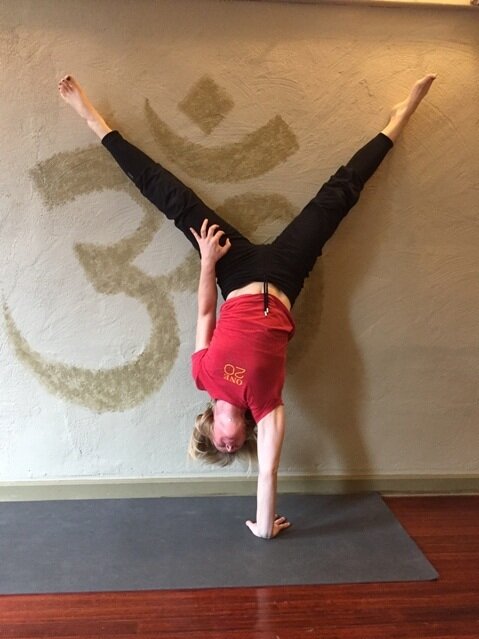Anna in One Arm Handstand
Practicing Inversions.
Developing Equanimity.
One of the things that makes yoga different from any other form of exercise is the practice of going upside down. Inversions are not for everyone and there are precautions to follow to be safe. The body has to be trained by the other poses and the student has to develop the awareness and sensitivity to know where the body is in space and what it is doing. But, inversions are very internalizing postures and they powerfully focus the mind.
Balancing postures, in general, develop poise. Hand balancing poses such as handstand build confidence and strength. Because our upper limbs metaphorically connect us to each other, arm balances can strengthen these connections as well as help us maintain healthy boundaries. Hand balances can be very empowering postures, but they can also be very intimidating to new students. It is important to practice patience and proceed with caution.
While there is a certain amount of upper body strength required to move into Handstand. The posture is not as much about hard work and pushing, as much as it is about moving toward ease. The first thing to learn is to let go of fear and anxiety and begin to learn to find balance in the center of the skeleton. Think of stacking your bones like so many building blocks. In Handstand, you line up your forearms right under your upper arms so that your elbows are articulating in full extension and straightness. When your upper arms are in line with your torso and your torso is in line with your legs, your skeleton maximizes your ability to support your weight. This articulation takes some time to reach since your joints need to open up and your muscular body needs to support you. It is important to master this basic skill before moving into the pose variations. The flexibility to extend the arms in line with the torso is developed in the various positions of the arms in the standing poses.
While the pose of the month is one arm Handstand, it is important to work up to it progressively. The action of the arms starts in Child’s Pose, progresses to Downward Facing Dog and moves into two arm Handstand. As a rule of thumb, it is a good idea to be able to hold regular Handstand for a full minute with your arms completely straight, stacking the bones for stability and ease before you think about trying to balance on one arm. Other benchmark skills are one minute Side Plank and the ability to do pushups.
Last month when we were working on Astavakrasana, one student finally got into the pose after 15 years of practice. When I was searching up one arm Handstand online, I read one person’s story about how it took him 14 weeks of practicing four to six hours a day, six days a week. Results are faster the more you practice, but this is just to remind you not to expect results in one day. Whether your goal is to get into Handstand or one arm Handstand, patience and perseverance are important. And, achieving the pose is not important. As Krishna says to Arjuna in the Bhagavad Gita:
You have the right to your actions,
But never to your action’s fruits.
Act for the action’s sake.
And do not be attached to inaction.
Self possessed, resolute act
Without any thought of results
Open to success or failure.
This equanimity is yoga.
BG 2.47-48



